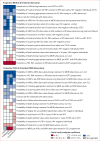Estimating the future burden of multidrug-resistant and extensively drug-resistant tuberculosis in India, the Philippines, Russia, and South Africa: a mathematical modelling study
- PMID: 28499828
- PMCID: PMC5599934
- DOI: 10.1016/S1473-3099(17)30247-5
Estimating the future burden of multidrug-resistant and extensively drug-resistant tuberculosis in India, the Philippines, Russia, and South Africa: a mathematical modelling study
Abstract
Background: Multidrug-resistant (MDR) and extensively drug-resistant (XDR) tuberculosis are emerging worldwide. The Green Light Committee initiative supported programmatic management of drug-resistant tuberculosis in 90 countries. We used estimates from the Preserving Effective TB Treatment Study to predict MDR and XDR tuberculosis trends in four countries with a high burden of MDR tuberculosis: India, the Philippines, Russia, and South Africa.
Methods: We calibrated a compartmental model to data from drug resistance surveys and WHO tuberculosis reports to forecast estimates of incident MDR and XDR tuberculosis and the percentage of incident MDR and XDR tuberculosis caused by acquired drug resistance, assuming no fitness cost of resistance from 2000 to 2040 in India, the Philippines, Russia, and South Africa.
Findings: The model forecasted the percentage of MDR tuberculosis among incident cases of tuberculosis to increase, reaching 12·4% (95% prediction interval 9·4-16·2) in India, 8·9% (4·5-11·7) in the Philippines, 32·5% (27·0-35·8) in Russia, and 5·7% (3·0-7·6) in South Africa in 2040. It also predicted the percentage of XDR tuberculosis among incident MDR tuberculosis to increase, reaching 8·9% (95% prediction interval 5·1-12·9) in India, 9·0% (4·0-14·7) in the Philippines, 9·0% (4·8-14·2) in Russia, and 8·5% (2·5-14·7) in South Africa in 2040. Acquired drug resistance would cause less than 30% of incident MDR tuberculosis during 2000-40. Acquired drug resistance caused 80% of incident XDR tuberculosis in 2000, but this estimate would decrease to less than 50% by 2040.
Interpretation: MDR and XDR tuberculosis were forecast to increase in all four countries despite improvements in acquired drug resistance shown by the Green Light Committee-supported programmatic management of drug-resistant tuberculosis. Additional control efforts beyond improving acquired drug resistance rates are needed to stop the spread of MDR and XDR tuberculosis in countries with a high burden of MDR tuberculosis.
Funding: US Agency for International Development and US Centers for Disease Control and Prevention, Division of Tuberculosis Elimination.
Copyright © 2017 Elsevier Ltd. All rights reserved.
Figures




Comment in
-
Drug-resistant tuberculosis threatens WHO's End-TB strategy.Lancet Infect Dis. 2017 Jul;17(7):674-675. doi: 10.1016/S1473-3099(17)30246-3. Epub 2017 May 9. Lancet Infect Dis. 2017. PMID: 28499827 No abstract available.
-
Multidrug-resistant tuberculosis: pharmacokinetic and pharmacodynamic science.Lancet Infect Dis. 2017 Sep;17(9):898. doi: 10.1016/S1473-3099(17)30449-8. Lancet Infect Dis. 2017. PMID: 28845791 No abstract available.
References
-
- WHO. WHO/HTM/TB/2016.13. Geneva: World Health Organization; 2016. Global tuberculosis report.
-
- UN. The Millenium Development Goals report. New York: United Nations; 2014.
-
- Blower SM, Chou T. Modeling the emergence of the hot zones: tuberculosis and the amplification dynamics of drug resistance. Nat Med. 2004;10:1111–16. - PubMed
Publication types
MeSH terms
Substances
Grants and funding
LinkOut - more resources
Full Text Sources
Other Literature Sources

